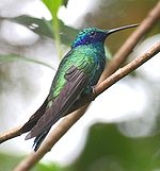
Sparkling Violet-ear
Encyclopedia
The Sparkling Violetear, Colibri coruscans, is a species of hummingbird
. It is widespread in highlands of northern and western South America
, including a large part of the Andes
(from Argentina
and northwards), the Venezuelan Coastal Range
and the Tepuis. It occurs in a wide range of semi-open habitats, even in gardens and parks within major cities such as Quito
, and is often the commonest species of hummingbird in its range. The Sparkling Violetear is most abundant near coniferous or evergreen eucalyptus
forests. It is highly vocal and territorial
.
The Sparkling Violetear is the largest violetear at 13 to 15 cm (5-6 in) long. Male birds weigh 7.7 to 8.5 grams(0.27 to 0.3 oz) while females weigh from ounces 6.7 to 7.5 grams (0.24 to 0.26 oz). This hummingbird resembles the Green Violetear, but that species generally prefers more humid habitats, is obviously smaller and lacks the distinct purple-blue chest-spot and chin of the Sparkling Violetear.
Sparkling Violetears are solitary and aggressive. Birds declare their territory by singing. The birds sing much of the day, and (in different parts of their range) sub-groups develop their own calls. Breeding seasons vary by region. Birds in Venezuela mate from July through October. Birds find mates at leks, areas where groups of males try to attract a female to mate. After mating, the male was once believed to leave all nesting responsibilities to the female. However, according to reports, male sparkling violet-ears were seen twice caring for their young. The mother lays two eggs in a tiny, cup-shaped nest made of twigs and other plant material. Eggs hatch in 17 to 18 days. The young fledge in three weeks.
Hummingbird
Hummingbirds are birds that comprise the family Trochilidae. They are among the smallest of birds, most species measuring in the 7.5–13 cm range. Indeed, the smallest extant bird species is a hummingbird, the 5-cm Bee Hummingbird. They can hover in mid-air by rapidly flapping their wings...
. It is widespread in highlands of northern and western South America
South America
South America is a continent situated in the Western Hemisphere, mostly in the Southern Hemisphere, with a relatively small portion in the Northern Hemisphere. The continent is also considered a subcontinent of the Americas. It is bordered on the west by the Pacific Ocean and on the north and east...
, including a large part of the Andes
Andes
The Andes is the world's longest continental mountain range. It is a continual range of highlands along the western coast of South America. This range is about long, about to wide , and of an average height of about .Along its length, the Andes is split into several ranges, which are separated...
(from Argentina
Argentina
Argentina , officially the Argentine Republic , is the second largest country in South America by land area, after Brazil. It is constituted as a federation of 23 provinces and an autonomous city, Buenos Aires...
and northwards), the Venezuelan Coastal Range
Venezuelan Coastal Range
The Venezuelan Coastal Range is a mountain range that runs along the central and eastern portions of Venezuela's northern coast...
and the Tepuis. It occurs in a wide range of semi-open habitats, even in gardens and parks within major cities such as Quito
Quito
San Francisco de Quito, most often called Quito , is the capital city of Ecuador in northwestern South America. It is located in north-central Ecuador in the Guayllabamba river basin, on the eastern slopes of Pichincha, an active stratovolcano in the Andes mountains...
, and is often the commonest species of hummingbird in its range. The Sparkling Violetear is most abundant near coniferous or evergreen eucalyptus
Eucalyptus
Eucalyptus is a diverse genus of flowering trees in the myrtle family, Myrtaceae. Members of the genus dominate the tree flora of Australia...
forests. It is highly vocal and territorial
Territory (animal)
In ethology the term territory refers to any sociographical area that an animal of a particular species consistently defends against conspecifics...
.
The Sparkling Violetear is the largest violetear at 13 to 15 cm (5-6 in) long. Male birds weigh 7.7 to 8.5 grams(0.27 to 0.3 oz) while females weigh from ounces 6.7 to 7.5 grams (0.24 to 0.26 oz). This hummingbird resembles the Green Violetear, but that species generally prefers more humid habitats, is obviously smaller and lacks the distinct purple-blue chest-spot and chin of the Sparkling Violetear.
Sparkling Violetears are solitary and aggressive. Birds declare their territory by singing. The birds sing much of the day, and (in different parts of their range) sub-groups develop their own calls. Breeding seasons vary by region. Birds in Venezuela mate from July through October. Birds find mates at leks, areas where groups of males try to attract a female to mate. After mating, the male was once believed to leave all nesting responsibilities to the female. However, according to reports, male sparkling violet-ears were seen twice caring for their young. The mother lays two eggs in a tiny, cup-shaped nest made of twigs and other plant material. Eggs hatch in 17 to 18 days. The young fledge in three weeks.

